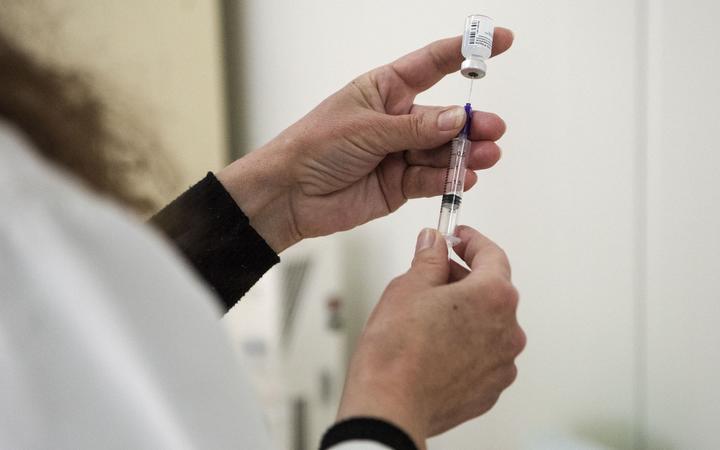Nine days shy of a year since the country’s first confirmed case, the first Covid-19 vaccine in New Zealand will be given today.

Vaccinators are the first in the queue to get the jab of the Pfizer-BioNTech Covid-19 vaccine. Photo: AFP
The first people immunised will not be border workers or their families but vaccinators – the people with the important job of administering the shots.
The government says months have gone into planning the logistics of the transport and distribution of the vaccines. The first here, and the only Medsafe-approved so far, is the Pfizer-BioNTech vaccine, requiring constant storage at -70C.
Dr Joe Bourne, part of the Covid vaccine immunisation programme, said with training and dress rehearsals now complete, they were ready for the rollout.
“We’ve had a number of test runs that have looked at a different part of the process. That’s gone from end-to-end: from receiving the vaccine into the country, storing it, distributing it, getting it to an immunisation site.”
He said the vaccination rollout here would be very different to other countries where Covid-19 was rampant, and governments wanted to vaccinate their populations as fast as possible.
“When people see the numbers being vaccinated on a daily basis at the beginning of this programme, those numbers will be considerably smaller than those that we see overseas. That’s because our context is so different.”
Vaccinators had what they call a “dry run” on Wednesday in Auckland, Wellington and Christchurch.
Part of the training included what to do when things go wrong, for example: what happens if someone drops a box of the vaccines? What if someone comes in who is sick?
Bourne said it made sense for the vaccinators to be the first in the queue.
“This is an opportunity for the vaccinators to actually handle the material they are going to be using. By the nature of the role, they will be coming into contact with people who are at the border. It felt like a sensible cohort to be doing the vaccinations on.”
The vaccinators are mostly nurses, now all schooled on the particulars of the Pfizer-BioNTech vaccine.
Nurses Organisation professional nursing advisor Kate Weston said the group – all authorised vaccinators before this – were more than ready.
“They’ve already got the base education skill and knowledge because that’s their role. And they’ve had preparation and specific education on the vaccine itself.”
Specialist supply chain company Kaptura chief executive Mark Singh said moving something this important at such low temperatures was a high-tech challenge.
He said “cold chain”, the term for moving refrigerated goods, did not even fit the bill for this vaccine; this was in the cryogenic range.
“It becomes a cryogenic chain; anything which goes below [negative] 40 goes into the cryogenic space, from a logistics perspective. That becomes a whole different ball game. It is literally like moving nuclear medicine. The closest comparison is when radioactive items are being moved.”
He said every box of vials of the vaccine would have live GPS monitoring, with statistics on its temperature, humidity, even how much they were tilted, and fed to monitored computers.
Singh said if anything started to go wrong, constant monitoring meant action could be taken to prevent that. For example, the vials starting to warm up.
“So if you have said that two to eight degrees is my tolerance limit, if anything reaches six degrees I need to know about it, so that before it crosses eight I can take some action on it. That’s something which is possible in real time, to get that kind of information.”
The process of developing a vaccine through to approval often takes a decade or more.
This time last year New Zealand had zero known cases. Today the first shot that may herald the beginning of the end of the pandemic will be given.
